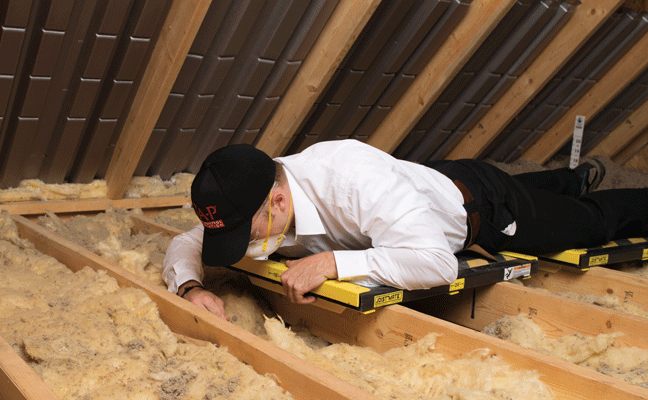
A PMP inspects the condition of existing attic insulation. PHOTO: PEST CONTROL INSULATION
Are you looking to boost revenue and grow your customer base while earning referrals? Try looking in the attic.
More specifically, it could be worth exploring offering pest preventing, loose fill (also known as blown-in) insulation services for your customers’ attics. Blown-in and foamboard insulation are two valid means of protection for basements and crawlspaces, too. Polyurethane spray foam insulation (PSFI) is yet another option, but if installed incorrectly, it can cause problems for pest inspections down the line and is beyond the scope of this article. (Editor’s Note: For the Association of Structural Pest Control Regulatory Officials’ take on PSFI, please see Pest Management Professional’s November 2019 issue here.)
FIRST THINGS FIRST
With borate-impregnated product available to pest management professionals (PMPs) via their industry distributors, online direct and even, in some cases, via big box stores (but to small-scale professionals only, not competing with do-it-yourselfers), there are three main ways, in no particular order, in which you can offer insulation services to new and existing customers:
⦁ Basic service is ensuring there is a proper amount of clean insulation to save customers on heating and cooling costs — up to 30 percent, say some sources. Insulation done right also provides them with a quieter environment, and helps to protect their homes from wildlife, rodents and other pests, both as a physical barrier to entry and by reducing moisture levels from condensation and other factors. It is typically bundled with exclusion services.
⦁ Attic capping involves blowing in insulation directly on top of existing insulation, or “capping off.” It can be bundled with quarterly pest control services.
⦁ Attic restoration involves removing soiled insulation and replacing it with new insulation. It can be bundled as part of a whole-house treatment for pest control and prevention.
These insulation services can be performed by your team, subcontracted, or you can take a hybrid approach. A lot of information is out there regarding this market segment, but in addition to the highlights that follow, know that your supplier and distributor representatives can help answer specific questions.
Common pest control industry insulation products include Thermal Acoustical Pest Control (TAP) from Pest Control Insulation (PCI), which features technical-grade borate (orthoboric acid). Because it’s registered by the U.S. Environmental Protection Agency as a pesticide, TAP only needs to be applied by a pesticide license holder; no insulation contractor license is required.
Other borate-impregnated products include Supreme Plus (for residential and commercial use) and ChickShredz (for agricultural use). Both blown-in insulation products are manufactured by Service Partners, and feature the Zone Defense additive with hydrogen borate. Bora-Foam from Crawlspace Depot, meanwhile, is a sodium borate-impregnated insulated foamboard product for crawlspaces and basements.
Depending on your state and local regulations, your homeowner customers — and, if you are working in new-construction, your builder customers — may qualify for special tax credits and incentives from energy-saving program initiatives. To see what is available in your market, visit the Database of State Incentives for Renewables & Efficiency (DSIRE) at DSIREUSA.org.
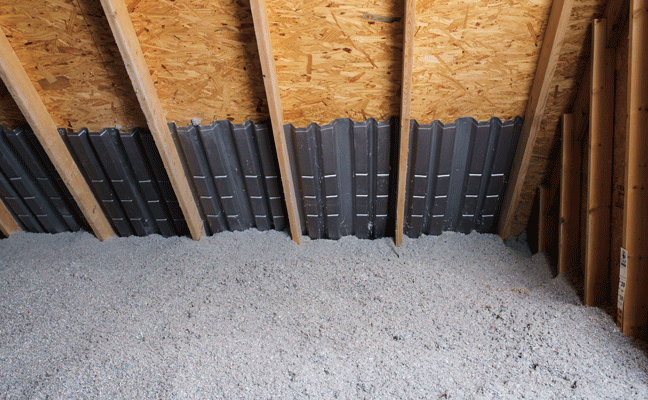
A job completed using TAP insulation. PHOTO: PEST CONTROL INSULATION
PMPs LEARN THE ROPES
Glen Ramsey, BCE, senior manager of technical services for the Rollins Support Center in Atlanta, Ga., notes that Orkin Pest Control’s history with insulation goes back to the early 1990s — but with the more traditional fiberglass batts and rolls. The firm officially launched its borate blown-in insulation service in 2001.
Bundling insulation services with existing pest services, Ramsey says, is key to profitability for PMPs.
“If we do some exclusion work and the insulation is damaged, then we offer a remediation including new insulation,” Ramsey offers as an example. “If we determine the customer needs a higher R-value than they have, then we can offer a capping service. It is always attempted to be coupled with another pest control service, if possible.”
Ramsey says the company’s insulation services are offered as an add-on at the time of any sale.
“Whenever we have a customer contact point, we try to provide services they need or that will improve the value of, and investment in, their homes,” he continues. “We developed marketing materials to support the sales process and describe the benefits of the insulation we use.”

Ryan Gates, ACE
Ryan Gates, ACE, is regional sales manager for Knox Pest Control, Columbus, Ga. The company strives to make itself one-stop-shopping for customers, offering lawn, wildlife and termite services in addition to residential and commercial pest control.
“We started out doing only crawlspace insulation, and that really hindered us because we could only service homes that had crawlspaces,” Gates recalls. “I wanted to be able to offer this service to all types of home construction and provide the best service possible.”
In January 2018, the company launched a program geared to its current customer base, and it took off faster than expected.
“Our first year, it added $100,000 to our bottom line. We’re on track to double that in 2019, our second year,” he says. “We are very happy to provide a host of services to our customers, and our customers have been extremely happy with that aspect.”
In many cases, Gates notes, Knox bundles insulation service with its wildlife program because the two play in the same space.
“Overall, our customers have been extremely happy with the added service and the value insulation brings in lowering heating and cooling costs,” he says.
Still, the borate ingredient in these products available today also can protect your customers from several of the usual general pest control suspects, including cockroaches, carpenter ants, silverfish and darkling beetles.
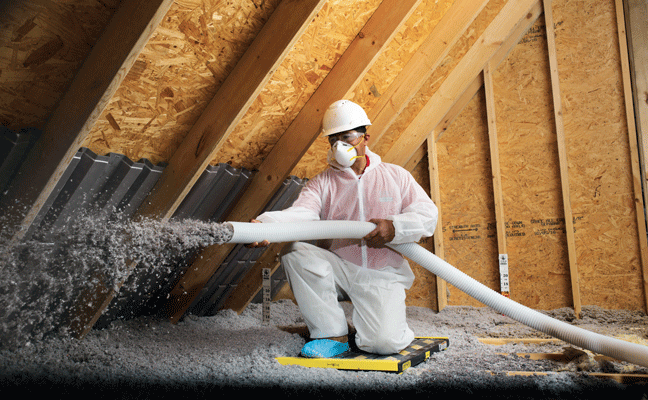
The insulation blow-in process uses equipment that is minimally disruptive to occupants. PHOTO: PEST CONTROL INSULATION

Robert Keef
Robert Keef, owner of Bay Pest Solutions, San Jose, Calif., has been selling insulation service for more than a decade. He notes that he saw the value of the service during his 35-year stint at a larger pest control firm, so when he struck out on his own, it became part of his plans.
“We bundle the insulation service with our wildlife exclusion service to help eliminate fecal matter and urine from rodents,” Keef says, noting that the service is outsourced and the insulation company comes in to help train his employees on how best to work together.
Keef says that while outsourcing means he doesn’t have control over when the job can be completed, because of the subcontracting company’s availability, there definitely are more benefits than drawbacks.
“They’re trained to perform this service, and we don’t have to buy any equipment or vehicles,” Keef adds. “We’re reaching new audiences, and market the service with our wildlife services. Customers are very open to having one company perform their home services this way.”
Marietta, Ga.-based Northwest Exterminating has been offering insulation long before its acquisition by Rollins in 2017. When it began offering wildlife removal and exclusion to its list of home services in 2006, says Regional Sales Manager David Niles, attic insulation service seemed like a natural fit.
“Considering all the benefits the insulation can bring to our customer’s home, it seemed like a no-brainer for us,” he continues. “We started training to ensure we could deliver the care our customers deserved, and we have been performing the insulation service for more than 13 years.”
Niles says attic insulation service is “a great second step for some customers who may be experiencing critters in their attics,” after exclusion.
“We can bundle our wildlife exclusion and attic insulation services together for customers where there may be a benefit to their homes,” he says, adding that they also perform attic insulation as a standalone service for customers who need soiled insulation removed or their current insulation topped off.

David Niles
Northwest has expanded its insulation involvement from wildlife and rodent customers to termite customers, too, Niles says.
“Our current customers’ yearly termite inspection involves our teammates checking the attic for signs of pests, wildlife, termite or insulation issues,” he explains. “Because of these and other routine checks, we often are able to catch concerns for our customers and let them know about this service we offer. Though we do try to reach potential customers through some of our advertising efforts, we primarily focus on educating our current Northwest customers on attic insulation and its potential benefits for their home.”
Attic insulation installation is less disruptive to customers than, say, a fumigation, where they have to vacate the structure. In most cases, the setup process is straightforward: Equipment is mounted on the truck, so only a 3-inch-diameter hose is brought into the structure. To keep dust to a minimum, the crew lays plastic tarps on surrounding floors, walls and around the attic access point. In the attic itself, the crew preps recessed lighting, eave vents, attic fans, exhaust flues, etc., so that the insulation is kept at least 3 inches away from such fixtures with some sort of barrier. It’s a good idea to install an R-value ruler, so in the future, you can tell at a glance how much the insulation has tamped down to over time. In most cases, blown-in insulation won’t need to be to topped off for at least 15 years if it’s kept clean and dry.
After installation, the crew affixes a warranty card and inspects their work before considering the job complete.
TRAINING
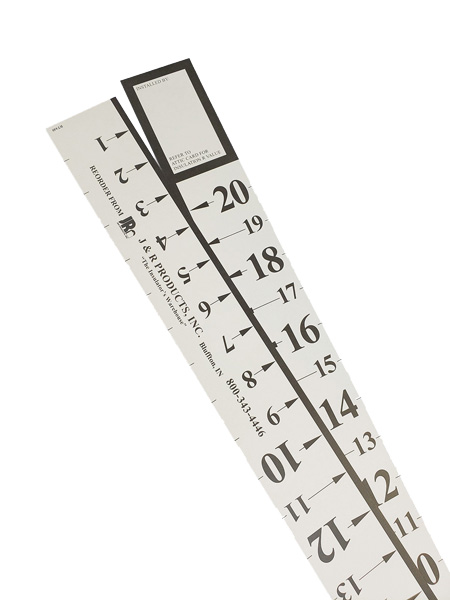
Installing an “R stick,” or attic ruler, can help determine whether the depth of insulation is sufficient as the years pass. PHOTO: J&R PRODUCTS INC.
The process might be straightforward, but it’s not exactly intuitive. Insulation suppliers are well-equipped to help PMPs learn the process, and continue to fine-tune it once they have the basics down. Reinforcing concepts with training, which PCI in particular offers its PMP customers directly, can then take a crew from great to outstanding. PCI also helps PMPs calculate the amount of product needed with an online calculator at TAPInsulation.com/bag-calculator.
Gates says Knox Pest Control has a dedicated team that provides attic insulation services, and staff is trained monthly, from sales to service.
“We are able to perform the service in-house, which means customers aren’t dealing with a number of different contractors,” he says. “It is also a full benefit to us, because we don’t have to pay any outsourcing fees, and we are able to tie the price into one simple concept for the customer so that we don’t overwhelm them with different contractors coming in.”
The company is in the beginning stages of offering the service, and is introducing it to current customers. Gates says he has not yet aggressively marketed insulation outside of its customer base, which is substantial enough to support the program as of now. He also has received a lot of referrals.
Ramsey notes Rollins’ training consists of an internal training and certification program that all sales and installation teams must pass to be able to sell or provide insulation services. In some branches, the team members are separate from its general pest control service technicians whereas in others, they are the same. And in some cases, Rollins subcontracts the work.
“The benefits to subcontracting are that we can offer the service in areas that might not do it often and don’t want to invest in the equipment needed to do it properly,” Ramsey says. “The drawbacks are the same with any subcontractor: You have to vet their work because your reputation is attached to their work.”
Northwest’s service is all in-house. As Attic Insulation Supervisor Don Saladrigas points out, “Our insulation team is part of our wildlife department. We use our vendor’s resources, ongoing internal training classes, and on-the-job training for our teammates who work specifically with our attic insulation service.”
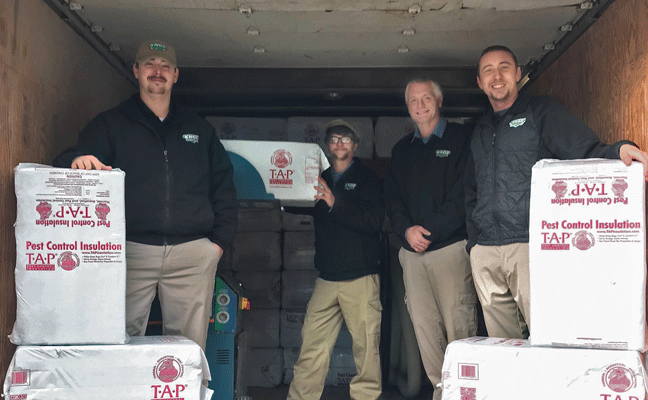
The Knox Pest Control install team includes, from left, Steven Brock, Dylan Craig, Dustin Hester and Michael Ott. PHOTO: KNOX PEST CONTROL
TIPS BEFORE TAKING THE LEAP
“Make sure you can provide the service at a very high standard. Train staff consistently, and make sure you have a future forecasting plan for the insulation side. This program also ties into our industry as a whole, as we are in attics all day, every day. We provide wildlife services and rodent control, which are your main reasons to be in attics. You’re not only giving your staff more opportunity, but it will help your company’s bottom line. The attic program provides a great service not only for our company, but for our customers as well.”
— Ryan Gates, ACE, Knox Pest Control
“Insulation is a very profitable service, and it will help with customer retention. If you do not offer it, you risk the customer going to a competitor for one-stop shopping.”
— Robert Keef, Bay Pest Solutions
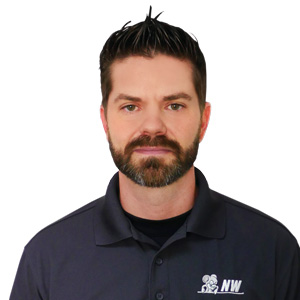
Don Saladrigas
“Really look at the investment and training that is needed to do the service correctly. Pay attention to local codes, and ensure you get the appropriate licensing needed in your particular service area. Consider partnering with another company that does this, and sub work out to see if it is something you want to get into further. Work through your state association contacts and see if you can ride along with another company doing a job. Participate, and ask about safety and risks. Then, make a decision on offering it as a service line.”
— Glen Ramsey, BCE, Rollins Inc.
“If you feel this service could benefit the customers you serve, do your research and find a vendor you trust. From our experience, most attics need more insulation, so the attic insulation service is something that can greatly benefit your customers — not only from an insulation perspective, but also from a pest prevention standpoint. In some cases, we have been able to remove old or soiled insulation without having to add new insulation. We have found many ways this service further allows us to care for our customers.”
— Don Saladrigas, Northwest Exterminating Co.
Read more:
Leave A Comment